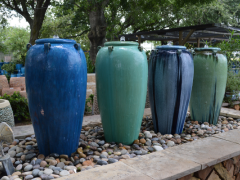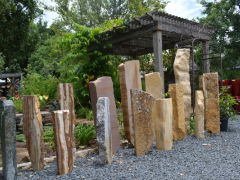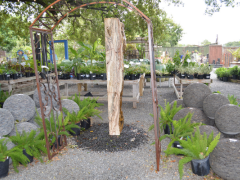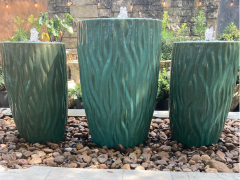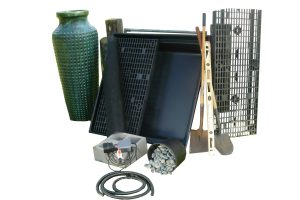 Disappearing Fountains offer an almost endless multitude of possibilities. A disappearing fountain can be created with a single piece of pottery, multiple pieces of pottery, natural or carved stone pieces, metal statues, or almost anything! We even made one out of a garbage can just to prove our point!
Disappearing Fountains offer an almost endless multitude of possibilities. A disappearing fountain can be created with a single piece of pottery, multiple pieces of pottery, natural or carved stone pieces, metal statues, or almost anything! We even made one out of a garbage can just to prove our point!
Take a walk through our yard, and you’ll quickly see that picking a piece for your disappearing fountain can be a bit overwhelming. Virtually any of the thousands of pieces of pottery, stone columns, sculptures, or vessels you see at Nelson Water Gardens can be transformed into a disappearing fountain.
Our friendly and knowledgeable staff can expertly guide you in the right direction and help you find the perfect piece to fit your style, and space. Not up to the challenge of installing the fountain yourself? Nelson’s can do the installation for you!
How to Install a Disappearing Fountain
A Disappearing Fountain is a great way to add the sound and movement of water to your garden! Water is pumped from a hidden reservoir buried in the ground, through the fountain piece and then seemingly disappears back into the ground. With our NWG Pre-molded Reservoirs, installing a Disappearing Fountain is easier than ever! Disappearing Fountains can be created from nearly anything. Traditional choices are decorative pots, statues, fountains or waterfalls. We even created a Disappearing Fountain from a trash can just to prove our point.
Pot or Piece Choices
Granite, Basalt, Onyx, Travertine, Calcite, Petrified Wood, and other stone pieces will last virtually forever. Glazed Pots and Cast Stone Statuary come in numerous sizes and shapes, in a wide range of colors and have a 20+ year life expectancy.
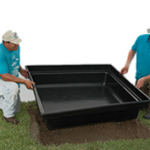
install reservoir

backfill around reservoir
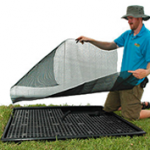
install grating & netting
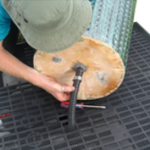
connect tubing
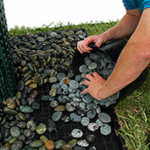
cover with rock topping
- Dig your hole about 11”-12″ deep and fill the bottom with 2″ of sand.
- Place the reservoir in the excavation and level.
- Backfill soil around the box packing in firmly.
- Place the cinder blocks in the box; one in each corner and one bridging the adjoining pieces of grating (including the trap door).
- Place 2-3 cinder blocks (depending on the piece) in the middle. For light pieces place the grating on top of the cinder blocks. Heavy pieces require several cinder blocks and must sit directly on the blocks with the grate cut away to go around the piece.
- Place the mesh over the grating; cut a hole in the mesh for the tubing.
- Connect the tubing to the piece (leave a fairly long piece of tubing exiting the fountain.)
- We use a stand pipe inside pots to create a nice plume of water over the top of the pot and to keep the pot from draining when the pump is off. Click here for more detail on plumbing a pot for use as a fountain.
- Connect the tubing to the pump and clamp.
- Thread the tubing through the cracks of the grating and slowly lower the piece into place. Once in place, level the pot using shims. Shims should only be placed directly over the thick supports in the grating to avoid sagging and shifting. Click here for more detail on proper shimming techniques.
- Place the pump inside the box. We recommend using a Danner Screen on the intake of the pump to protect the intake of the pump.
- Put the decorative topping around the piece on top of the grating and mesh.
- Turn on pump and enjoy.
We’ve learned this the hard way; always connect the tubing to the piece and then to the pump not the other way around. We also recommend installing a valve on all pumps to control the flow of water coming out of the piece to match your expectations.
Choose the right Reservoir
Although you may be tempted to opt for a smaller reservoir due to space, labor and cost considerations there are some good reasons to go with a larger reservoir.
- The larger the reservoir, the greater volume of water it can hold and the less often you need to re-fill it.
- Tall pieces 4′ or higher need a bigger box, water droplets have farther to fall and thus tend to splash out of the reservoir boundaries.
- Larger reservoirs give you the opportunity to add additional pieces to your fountain display.
- Larger reservoirs allow for a greater water flow creating more water “music”.
Reservoirs & Installation
All “Complete Reservoir Kits” include the reservoir, heavy-duty grating, cinder blocks, and ¼” plastic mesh.
Note: custom sized timber and rubber liner constructed boxes can be made for unique situations. Please ask for a quote.
*Installed price also includes Pump, Plumbing Supplies and your choice of Beach Pebbles, Pea Gravel or Black Star Gravel toppings.
Nelson Water Gardens & Nursery, Inc. accepts NO Responsibility for electrical work. We recommend using a licensed Electrician if an outlet needs to be added for your fountain. Pumps have 18′ cords. Before digging check for buried utilities, cables, and sprinkler systems. Call 811 to request a utility line locate. Call at least 72 hours prior to digging. This is a free service.
Mileage Charge of $1.00 per mile for each mile over 50 miles round trip.
Care of your Disappearing Fountain
The reservoir must be kept filled with water and can be accomplished in several ways:
- Fill the fountain as needed with a garden hose.
- Site the fountain near an irrigation head, so the sprinkler keeps the reservoir filled.
Nelson’s does not recommend using automatic fill devices because they frequently “stick” and don’t shut off.
The fountain piece will need to be scrubbed occasionally to remove algae and scale. Fountec (safe for birds and pets) can be used to control algae growth but must be added every week. Use Protec to minimize hard water stains (especially on dark fountains or fountains close to windows) on a monthly basis. Note: Some folks prefer the natural patina of algae on the pieces, in which case no scrubbing, or Fountec, is necessary.
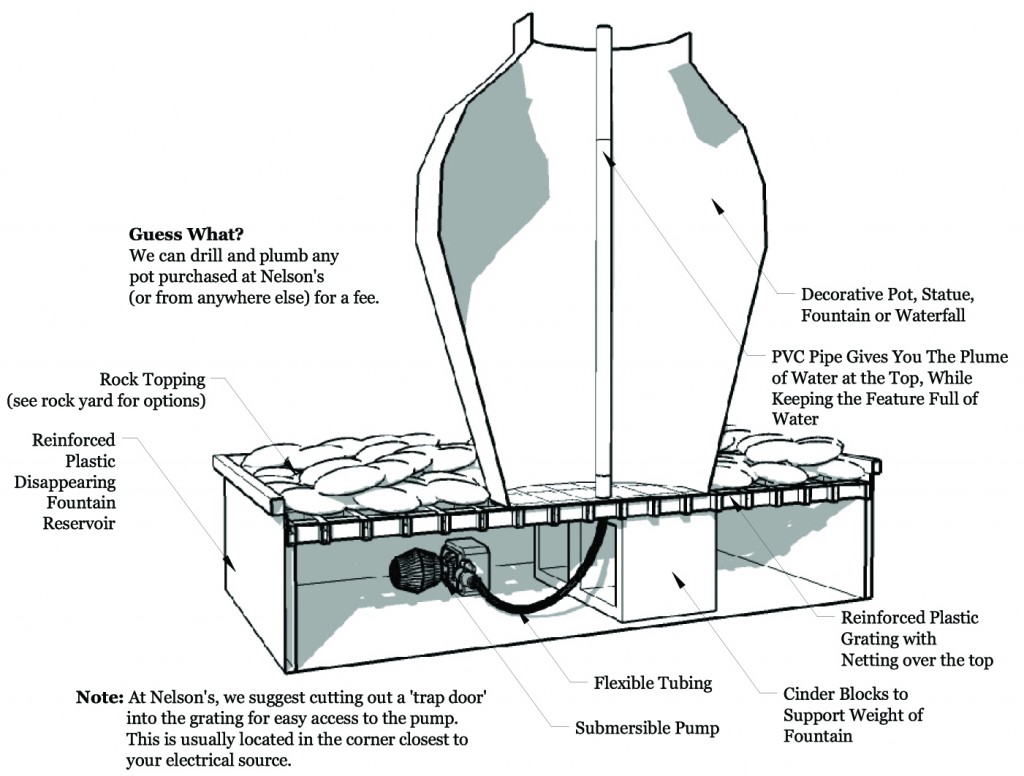
Click Here to Download a Printable PDF
